
List of Spanish monarchs
Encyclopedia
This is a list of Spanish monarchs that is, rulers of the country of Spain
in the modern sense of the word. The forerunners of the monarchs of the Spanish throne were the following:
These lineages were eventually united by the marriage of the Catholic Monarchs, Ferdinand II of Aragon
(king of the Crown of Aragon
) and Isabella I of Castile
(queen of the Crown of Castile
). Although their kingdoms continued to be separate, with their personal union
they ruled them together as one dominion. Ferdinand also conquered the southern part of Navarre
and annexed it to what was to become Spain. Isabella left her kingdom to her daughter Joanna of Castile
. Ferdinand served as her regent during her insanity
; though rebuffed by the Castilian nobility and replaced by Joanna's husband Philip the Handsome, he resumed his regency after Philip's death. In 1516, after Ferdinand II's death, his daughter Joanna inherited the kingdom of Aragon, but was kept prisoner at Tordesillas as insane. As Joanna's son, the future Holy Roman Emperor
Charles V, did not want to be merely a regent, he was proclaimed king of Castile and Aragon jointly with his mother in Brussels. Subsequently, Castilian and Aragonese Cortes alleged oath to him as co-king with his mother. Upon her death, he became sole King of Castile and Aragon, and the thrones were thereafter united permanently.
, as his successor. Upon any possible refusal the Crown of Spain would be offered next to Philip's younger brother Charles, duc de Berry, or, next, to Archduke Charles of Austria
.
Both claimants, Philip and Charles, had a legal right to the Spanish throne due to the fact that Philip's grandfather, King Louis XIV of France
and Charles's father, Leopold I, Holy Roman Emperor
, were sons of Charles' aunts, Anne of Austria
and Maria Anna of Austria. Philip had the better claim because his grandmother
and great-grandmother
were older than Leopold's. However, the Austrian branch claimed that Philip's grandmother had renounced the Spanish throne for herself and her descendants as part of her marriage contract. This was countered by the French branch's claim that it was on the basis of a dowry that had never been paid.
After a long council meeting where the Dauphin spoke up in favour of his son's rights, it was agreed that Philip would ascend the throne. Following this war broke out and Archduke Charles
was also proclaimed king of Spain, as Charles III in opposition to Philip V. Charles renounced his claims to the Spanish throne in the Treaty of Rastatt
of 1714, but was allowed the continued use of the styles of a Spanish monarch for his lifetime.
, imposed by his brother Emperor Napoleon I of France
after the kings Charles IV and Ferdinand VII abdicated. The title used by Joseph was King of the Spains and the Indias, by the Grace of God and the Constitution of the State. He was also later given all of the titles of the previous kings. A government in opposition to the French was formed in Cádiz
on 25 September 1808, which continued to recognize the imprisoned Ferdinand VII as king. This government was diplomatically recognized as the legitimate Spanish government by Britain and other countries at war with France.
deposed Isabella II, there was established a provisional government and a regency headed by Francisco Serrano y Domínguez from October 8, 1868 until January 2, 1871, while a new monarch was sought. Amadeo was elected as king and the new title used was King of Spain, by the Grace of God and will of the nation.
was proclaimed Head of State (Caudillo) in the parts of Spain controlled by the Nationalists (nacionales) after the Spanish Civil War
broke out. After the end of war on April 1, 1939 General Franco took control of the whole of Spain. In 1947, Franco proclaimed the restoration of the monarchy, but did not allow the pretender, Juan de Borbón, Count of Barcelona, to take the throne. In 1969, Franco declared that Juan Carlos, the Count of Barcelona's son, would be his successor. After Franco's death in 1975, Juan Carlos succeeded him as the King of Spain.
Spain
Spain , officially the Kingdom of Spain languages]] under the European Charter for Regional or Minority Languages. In each of these, Spain's official name is as follows:;;;;;;), is a country and member state of the European Union located in southwestern Europe on the Iberian Peninsula...
in the modern sense of the word. The forerunners of the monarchs of the Spanish throne were the following:
- Kings of Asturias
- Kings of Aragon
- Kings of Castile
- Kings of Galicia
- Kings of León
- Kings of Majorca
- Kings of Navarre
- Kings of Valencia
These lineages were eventually united by the marriage of the Catholic Monarchs, Ferdinand II of Aragon
Ferdinand II of Aragon
Ferdinand the Catholic was King of Aragon , Sicily , Naples , Valencia, Sardinia, and Navarre, Count of Barcelona, jure uxoris King of Castile and then regent of that country also from 1508 to his death, in the name of...
(king of the Crown of Aragon
Crown of Aragon
The Crown of Aragon Corona d'Aragón Corona d'Aragó Corona Aragonum controlling a large portion of the present-day eastern Spain and southeastern France, as well as some of the major islands and mainland possessions stretching across the Mediterranean as far as Greece...
) and Isabella I of Castile
Isabella I of Castile
Isabella I was Queen of Castile and León. She and her husband Ferdinand II of Aragon brought stability to both kingdoms that became the basis for the unification of Spain. Later the two laid the foundations for the political unification of Spain under their grandson, Charles V, Holy Roman Emperor...
(queen of the Crown of Castile
Crown of Castile
The Crown of Castile was a medieval and modern state in the Iberian Peninsula that formed in 1230 as a result of the third and definitive union of the crowns and parliaments of the kingdoms of Castile and León upon the accession of the then King Ferdinand III of Castile to the vacant Leonese throne...
). Although their kingdoms continued to be separate, with their personal union
Personal union
A personal union is the combination by which two or more different states have the same monarch while their boundaries, their laws and their interests remain distinct. It should not be confused with a federation which is internationally considered a single state...
they ruled them together as one dominion. Ferdinand also conquered the southern part of Navarre
Navarre
Navarre , officially the Chartered Community of Navarre is an autonomous community in northern Spain, bordering the Basque Country, La Rioja, and Aragon in Spain and Aquitaine in France...
and annexed it to what was to become Spain. Isabella left her kingdom to her daughter Joanna of Castile
Joanna of Castile
Joanna , nicknamed Joanna the Mad , was the first queen regnant to reign over both the Crown of Castile and the Crown of Aragon , a union which evolved into modern Spain...
. Ferdinand served as her regent during her insanity
Insanity
Insanity, craziness or madness is a spectrum of behaviors characterized by certain abnormal mental or behavioral patterns. Insanity may manifest as violations of societal norms, including becoming a danger to themselves and others, though not all such acts are considered insanity...
; though rebuffed by the Castilian nobility and replaced by Joanna's husband Philip the Handsome, he resumed his regency after Philip's death. In 1516, after Ferdinand II's death, his daughter Joanna inherited the kingdom of Aragon, but was kept prisoner at Tordesillas as insane. As Joanna's son, the future Holy Roman Emperor
Holy Roman Emperor
The Holy Roman Emperor is a term used by historians to denote a medieval ruler who, as German King, had also received the title of "Emperor of the Romans" from the Pope...
Charles V, did not want to be merely a regent, he was proclaimed king of Castile and Aragon jointly with his mother in Brussels. Subsequently, Castilian and Aragonese Cortes alleged oath to him as co-king with his mother. Upon her death, he became sole King of Castile and Aragon, and the thrones were thereafter united permanently.
House of Habsburg / House of Austria
Under Joanna and Charles I, the two thrones of Castile and Aragon were finally united under one monarch.| # | |Name | | | |Started | |Ended | |Title | |Relationship with predecessor(s) |
|---|---|---|---|---|---|---|
| 1 | Charles I Charles V, Holy Roman Emperor Charles V was ruler of the Holy Roman Empire from 1519 and, as Charles I, of the Spanish Empire from 1516 until his voluntary retirement and abdication in favor of his younger brother Ferdinand I and his son Philip II in 1556.As... |
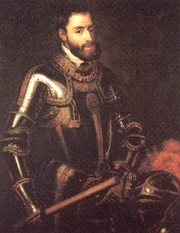 |
March 14, 1516 | January 16, 1556 | Holy Roman Emperor, King of the Romans, Italy and Spain, Archduke of Austria, (Titular) Duke of Burgundy |
son and co-monarch of Joanna Joanna of Castile Joanna , nicknamed Joanna the Mad , was the first queen regnant to reign over both the Crown of Castile and the Crown of Aragon , a union which evolved into modern Spain... ; grandson of Isabella I Isabella I of Castile Isabella I was Queen of Castile and León. She and her husband Ferdinand II of Aragon brought stability to both kingdoms that became the basis for the unification of Spain. Later the two laid the foundations for the political unification of Spain under their grandson, Charles V, Holy Roman Emperor... and Ferdinand II Ferdinand II of Aragon Ferdinand the Catholic was King of Aragon , Sicily , Naples , Valencia, Sardinia, and Navarre, Count of Barcelona, jure uxoris King of Castile and then regent of that country also from 1508 to his death, in the name of... |
| 2 | Philip II Philip II of Spain Philip II was King of Spain, Portugal, Naples, Sicily, and, while married to Mary I, King of England and Ireland. He was lord of the Seventeen Provinces from 1556 until 1581, holding various titles for the individual territories such as duke or count.... |
January 16, 1556 | September 13, 1598 | King of Spain, Naples and (from 1580) Portugal King of England and Ireland jure uxoris; Ruler of the Spanish Netherlands; Duke of Milan |
son of Charles I Charles V, Holy Roman Emperor Charles V was ruler of the Holy Roman Empire from 1519 and, as Charles I, of the Spanish Empire from 1516 until his voluntary retirement and abdication in favor of his younger brother Ferdinand I and his son Philip II in 1556.As... |
|
| 3 | Philip III Philip III of Spain Philip III , also known as Philip the Pious, was the King of Spain and King of Portugal and the Algarves, where he ruled as Philip II , from 1598 until his death... |
 |
September 13, 1598 | March 31, 1621 | King of Spain and Portugal | son of Philip II Philip II of Spain Philip II was King of Spain, Portugal, Naples, Sicily, and, while married to Mary I, King of England and Ireland. He was lord of the Seventeen Provinces from 1556 until 1581, holding various titles for the individual territories such as duke or count.... |
| 4 | Philip IV Philip IV of Spain Philip IV was King of Spain between 1621 and 1665, sovereign of the Spanish Netherlands, and King of Portugal until 1640... |
 |
March 31, 1621 | September 17, 1665 | King of Spain and (until 1640) Portugal | son of Philip III Philip III of Spain Philip III , also known as Philip the Pious, was the King of Spain and King of Portugal and the Algarves, where he ruled as Philip II , from 1598 until his death... |
| 5 | Charles II Charles II of Spain Charles II was the last Habsburg King of Spain and the ruler of large parts of Italy, the Spanish territories in the Southern Low Countries, and Spain's overseas Empire, stretching from the Americas to the Spanish East Indies... |
.jpg) |
September 17, 1665 | November 1, 1700 | King of Spain Ruler of the Spanish Netherlands |
son of Philip IV Philip IV of Spain Philip IV was King of Spain between 1621 and 1665, sovereign of the Spanish Netherlands, and King of Portugal until 1640... |
House of Bourbon
In the year 1700 Charles II died. Charles' will named the 16-year old Philip, the grandson of Charles' sister Maria Theresa of SpainMaria Theresa of Spain
Maria Theresa of Austria was the daughter of Philip IV, King of Spain and Elizabeth of France. Maria Theresa was Queen of France as wife of King Louis XIV and mother of the Grand Dauphin, an ancestor of the last four Bourbon kings of France.-Early life:Born as Infanta María Teresa of Spain at the...
, as his successor. Upon any possible refusal the Crown of Spain would be offered next to Philip's younger brother Charles, duc de Berry, or, next, to Archduke Charles of Austria
Charles VI, Holy Roman Emperor
Charles VI was the penultimate Habsburg sovereign of the Habsburg Empire. He succeeded his elder brother, Joseph I, as Holy Roman Emperor, King of Bohemia , Hungary and Croatia , Archduke of Austria, etc., in 1711...
.
Both claimants, Philip and Charles, had a legal right to the Spanish throne due to the fact that Philip's grandfather, King Louis XIV of France
Louis XIV of France
Louis XIV , known as Louis the Great or the Sun King , was a Bourbon monarch who ruled as King of France and Navarre. His reign, from 1643 to his death in 1715, began at the age of four and lasted seventy-two years, three months, and eighteen days...
and Charles's father, Leopold I, Holy Roman Emperor
Leopold I, Holy Roman Emperor
| style="float:right;" | Leopold I was a Holy Roman Emperor, King of Hungary and King of Bohemia. A member of the Habsburg family, he was the second son of Emperor Ferdinand III and his first wife, Maria Anna of Spain. His maternal grandparents were Philip III of Spain and Margaret of Austria...
, were sons of Charles' aunts, Anne of Austria
Anne of Austria
Anne of Austria was Queen consort of France and Navarre, regent for her son, Louis XIV of France, and a Spanish Infanta by birth...
and Maria Anna of Austria. Philip had the better claim because his grandmother
Maria Theresa of Spain
Maria Theresa of Austria was the daughter of Philip IV, King of Spain and Elizabeth of France. Maria Theresa was Queen of France as wife of King Louis XIV and mother of the Grand Dauphin, an ancestor of the last four Bourbon kings of France.-Early life:Born as Infanta María Teresa of Spain at the...
and great-grandmother
Anne of Austria
Anne of Austria was Queen consort of France and Navarre, regent for her son, Louis XIV of France, and a Spanish Infanta by birth...
were older than Leopold's. However, the Austrian branch claimed that Philip's grandmother had renounced the Spanish throne for herself and her descendants as part of her marriage contract. This was countered by the French branch's claim that it was on the basis of a dowry that had never been paid.
After a long council meeting where the Dauphin spoke up in favour of his son's rights, it was agreed that Philip would ascend the throne. Following this war broke out and Archduke Charles
Charles VI, Holy Roman Emperor
Charles VI was the penultimate Habsburg sovereign of the Habsburg Empire. He succeeded his elder brother, Joseph I, as Holy Roman Emperor, King of Bohemia , Hungary and Croatia , Archduke of Austria, etc., in 1711...
was also proclaimed king of Spain, as Charles III in opposition to Philip V. Charles renounced his claims to the Spanish throne in the Treaty of Rastatt
Treaty of Rastatt
The Treaty of Rastatt of 7 March 1714, ended hostilities between France and Austria at the end of the War of the Spanish Succession. It complemented the Treaty of Utrecht, which had, the previous year, ended hostilities with Britain and the Dutch Republic...
of 1714, but was allowed the continued use of the styles of a Spanish monarch for his lifetime.
| # | |Name | | | |Started | |Ended | |Title | |Relationship with predecessor(s) |
|---|---|---|---|---|---|---|
| 6 | Philip V Philip V of Spain Philip V was King of Spain from 15 November 1700 to 15 January 1724, when he abdicated in favor of his son Louis, and from 6 September 1724, when he assumed the throne again upon his son's death, to his death.Before his reign, Philip occupied an exalted place in the royal family of France as a... |
November 16, 1700 | January 14, 1724 (abdicated) | King of Spain | Great-grandson of Philip IV Philip IV of Spain Philip IV was King of Spain between 1621 and 1665, sovereign of the Spanish Netherlands, and King of Portugal until 1640... via his eldest daughter, Maria Theresa of Spain Maria Theresa of Spain Maria Theresa of Austria was the daughter of Philip IV, King of Spain and Elizabeth of France. Maria Theresa was Queen of France as wife of King Louis XIV and mother of the Grand Dauphin, an ancestor of the last four Bourbon kings of France.-Early life:Born as Infanta María Teresa of Spain at the... |
|
| 7 | Louis I | 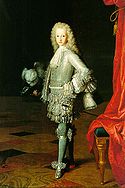 |
January 14, 1724 | August 31, 1724 | King of Spain | Son of Philip V Philip V of Spain Philip V was King of Spain from 15 November 1700 to 15 January 1724, when he abdicated in favor of his son Louis, and from 6 September 1724, when he assumed the throne again upon his son's death, to his death.Before his reign, Philip occupied an exalted place in the royal family of France as a... |
| 8 | Philip V Philip V of Spain Philip V was King of Spain from 15 November 1700 to 15 January 1724, when he abdicated in favor of his son Louis, and from 6 September 1724, when he assumed the throne again upon his son's death, to his death.Before his reign, Philip occupied an exalted place in the royal family of France as a... |
September 6, 1724 | July 9, 1746 | King of Spain | Father of Louis | |
| 9 | Ferdinand VI Ferdinand VI of Spain Ferdinand VI , called the Learnt, was King of Spain from 9 July 1746 until his death. He was the fourth son of the previous monarch Philip V and his first wife Maria Luisa of Savoy... |
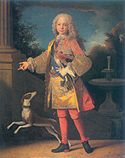 |
July 9, 1746 | August 10, 1759 | King of Spain | Son of Philip V Philip V of Spain Philip V was King of Spain from 15 November 1700 to 15 January 1724, when he abdicated in favor of his son Louis, and from 6 September 1724, when he assumed the throne again upon his son's death, to his death.Before his reign, Philip occupied an exalted place in the royal family of France as a... |
| 10 | Charles III Charles III of Spain Charles III was the King of Spain and the Spanish Indies from 1759 to 1788. He was the eldest son of Philip V of Spain and his second wife, the Princess Elisabeth Farnese... |
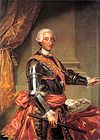 |
August 10, 1759 | December 14, 1788 | King of Spain, Naples and Sicily Duke of Parma |
Son of Philip V Philip V of Spain Philip V was King of Spain from 15 November 1700 to 15 January 1724, when he abdicated in favor of his son Louis, and from 6 September 1724, when he assumed the throne again upon his son's death, to his death.Before his reign, Philip occupied an exalted place in the royal family of France as a... |
| 11 | Charles IV Charles IV of Spain Charles IV was King of Spain from 14 December 1788 until his abdication on 19 March 1808.-Early life:... |
December 14, 1788 | March 19, 1808 | King of Spain | Son of Charles III Charles III of Spain Charles III was the King of Spain and the Spanish Indies from 1759 to 1788. He was the eldest son of Philip V of Spain and his second wife, the Princess Elisabeth Farnese... |
|
| 12 | Ferdinand VII |  |
March 19, 1808 | May 6, 1808 | King of Spain | Son of Charles IV Charles IV of Spain Charles IV was King of Spain from 14 December 1788 until his abdication on 19 March 1808.-Early life:... |
House of Bonaparte
The only monarch from this dynasty was JosephJoseph Bonaparte
Joseph-Napoléon Bonaparte was the elder brother of Napoleon Bonaparte, who made him King of Naples and Sicily , and later King of Spain...
, imposed by his brother Emperor Napoleon I of France
Napoleon I of France
Napoleon Bonaparte was a French military and political leader during the latter stages of the French Revolution.As Napoleon I, he was Emperor of the French from 1804 to 1815...
after the kings Charles IV and Ferdinand VII abdicated. The title used by Joseph was King of the Spains and the Indias, by the Grace of God and the Constitution of the State. He was also later given all of the titles of the previous kings. A government in opposition to the French was formed in Cádiz
Cádiz
Cadiz is a city and port in southwestern Spain. It is the capital of the homonymous province, one of eight which make up the autonomous community of Andalusia....
on 25 September 1808, which continued to recognize the imprisoned Ferdinand VII as king. This government was diplomatically recognized as the legitimate Spanish government by Britain and other countries at war with France.
| # | |Name | | | |Started | |Ended | |Title | |Relationship with predecessor(s) |
|---|---|---|---|---|---|---|
| 13 | Joseph |  |
June 6, 1808 | December 11, 1813 (deposed) | King of Spain King of Naples and Sicily and the Indies Comte de Survilliers |
none |
House of Bourbon (first restoration)
Charles IV's eldest son was restored to the throne. Again the title used was king of Castile, Leon, Aragon,… by the Grace of God.| # | |Name | | | |Started | |Ended | |Title | |Relationship with predecessor(s) |
|---|---|---|---|---|---|---|
| 14 | Ferdinand VII |  |
December 11, 1813 | September 29, 1833 | King of Spain | Son of Charles IV Charles IV of Spain Charles IV was King of Spain from 14 December 1788 until his abdication on 19 March 1808.-Early life:... |
| 15 | Isabella II Isabella II of Spain Isabella II was the only female monarch of Spain in modern times. She came to the throne as an infant, but her succession was disputed by the Carlists, who refused to recognise a female sovereign, leading to the Carlist Wars. After a troubled reign, she was deposed in the Glorious Revolution of... |
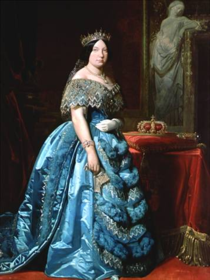 |
September 29, 1833 | September 30, 1868 (deposed) | Queen of Spain | Daughter of Ferdinand VII |
House of Savoy
After the Spanish Revolution of 1868Glorious Revolution (Spain)
The Glorious Revolution took place in Spain in 1868, resulting in the deposition of Queen Isabella II.An 1866 rebellion led by General Juan Prim and a revolt of the sergeants at San Gil barracks, in Madrid, sent a signal to Spanish liberals and republicans that there was serious unrest with the...
deposed Isabella II, there was established a provisional government and a regency headed by Francisco Serrano y Domínguez from October 8, 1868 until January 2, 1871, while a new monarch was sought. Amadeo was elected as king and the new title used was King of Spain, by the Grace of God and will of the nation.
| # | |Name | | | |Started | |Ended | |Title | |Relationship with predecessor(s) |
|---|---|---|---|---|---|---|
| 16 | Amadeo I Amadeo I of Spain Amadeo I was the only King of Spain from the House of Savoy... |
December 4, 1870 | February 11, 1873 | King of Spain |
House of Borbon (second restoration)
Isabella II's eldest son was restored to the throne as she had abdicated in his favour in 1870. Constitutional king of Spain.| # | |Name | | | |Started | |Ended | |Title | |Relationship with predecessor(s) |
|---|---|---|---|---|---|---|
| 17 | Alfonso XII Alfonso XII of Spain Alfonso XII was king of Spain, reigning from 1874 to 1885, after a coup d'état restored the monarchy and ended the ephemeral First Spanish Republic.-Early life and paternity:Alfonso was the son of Queen Isabella II of Spain, and... |
December 29, 1874 | November 25, 1885 | King of Spain | Son of Isabella II Isabella II of Spain Isabella II was the only female monarch of Spain in modern times. She came to the throne as an infant, but her succession was disputed by the Carlists, who refused to recognise a female sovereign, leading to the Carlist Wars. After a troubled reign, she was deposed in the Glorious Revolution of... |
|
| 18 | Alfonso XIII Alfonso XIII of Spain Alfonso XIII was King of Spain from 1886 until 1931. His mother, Maria Christina of Austria, was appointed regent during his minority... |
May 17, 1886 | April 14, 1931 | King of Spain | Posthumous son of Alfonso XII Alfonso XII of Spain Alfonso XII was king of Spain, reigning from 1874 to 1885, after a coup d'état restored the monarchy and ended the ephemeral First Spanish Republic.-Early life and paternity:Alfonso was the son of Queen Isabella II of Spain, and... |
Francoist Spain (1936–1975)
On October 1, 1936 General Francisco FrancoFrancisco Franco
Francisco Franco y Bahamonde was a Spanish general, dictator and head of state of Spain from October 1936 , and de facto regent of the nominally restored Kingdom of Spain from 1947 until his death in November, 1975...
was proclaimed Head of State (Caudillo) in the parts of Spain controlled by the Nationalists (nacionales) after the Spanish Civil War
Spanish Civil War
The Spanish Civil WarAlso known as The Crusade among Nationalists, the Fourth Carlist War among Carlists, and The Rebellion or Uprising among Republicans. was a major conflict fought in Spain from 17 July 1936 to 1 April 1939...
broke out. After the end of war on April 1, 1939 General Franco took control of the whole of Spain. In 1947, Franco proclaimed the restoration of the monarchy, but did not allow the pretender, Juan de Borbón, Count of Barcelona, to take the throne. In 1969, Franco declared that Juan Carlos, the Count of Barcelona's son, would be his successor. After Franco's death in 1975, Juan Carlos succeeded him as the King of Spain.
House of Borbon (third restoration)
Alfonso XIII's claim descended (due to his two eldest sons' renunciations) to his third son, Infante Juan, Count of Barcelona, who was passed over in favour of his eldest son, whose title is King of Spain. The Count of Barcelona renounced his claims in favour of his son in 1977, two years after Franco's death and Juan Carlos's accession.| # | |Name | | | |Started | |Ended | |Title | |Relationship with predecessor(s) |
|---|---|---|---|---|---|---|
| 19 | Juan Carlos I | 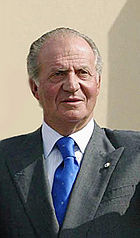 |
November 22, 1975 | Incumbent Incumbent The incumbent, in politics, is the existing holder of a political office. This term is usually used in reference to elections, in which races can often be defined as being between an incumbent and non-incumbent. For example, in the 2004 United States presidential election, George W... |
King of Spain | Grandson of Alfonso XIII Alfonso XIII of Spain Alfonso XIII was King of Spain from 1886 until 1931. His mother, Maria Christina of Austria, was appointed regent during his minority... , via his son Infante Juan, Count of Barcelona |
See also
- List of heads of state of Spain
- Kings of Spain family treeKings of Spain family treeThis is a collection of the family trees of the kingdom of Spain. The former kingdoms of Aragon, Castile and Navarre were independent kingdoms that unified in the 15th century to become the Kingdom of Spain....
- Line of Succession to the Spanish Throne
- Royal Consorts of SpainRoyal Consorts of Spain- House of Habsburg :- House of Bourbon :- House of Bonaparte :- House of Bourbon :- House of Savoy :- House of Bourbon :-See also:*List of Spanish monarchs*List of Aragonese consorts...
- Spanish monarchySpanish monarchyThe Monarchy of Spain, constitutionally referred to as The Crown and commonly referred to as the Spanish monarchy or Hispanic Monarchy, is a constitutional institution and an historic office of Spain...
- War of the Spanish SuccessionWar of the Spanish SuccessionThe War of the Spanish Succession was fought among several European powers, including a divided Spain, over the possible unification of the Kingdoms of Spain and France under one Bourbon monarch. As France and Spain were among the most powerful states of Europe, such a unification would have...

